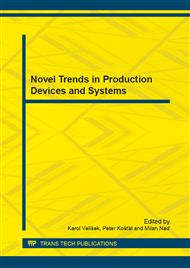[1]
B. J. Pine, Mass customization: The New Frontier in Business Competition, first ed., Massachusetts, Harvard Business School Press, (1992).
Google Scholar
[2]
N. J. A. Sloane, A handbook of integer sequences, first ed., New York, Academic Press, (1973).
Google Scholar
[3]
X. Zhu, S. J. Hu, Y. Koren, S. P. Marin, Modeling of Manufacturing Complexity in Mixed-Model Assembly lines, J. Manuf. Sci. E-T Asme., 130 (2007) 1-50.
Google Scholar
[4]
H. Wang, D. Ceglarek, Quality-driven, Sequence Planning and Line Configuration Selection for Compliant Structure Assemblies, CIRP Ann. -Manuf. Techn. 54 (2005) 31-35.
DOI: 10.1016/s0007-8506(07)60043-2
Google Scholar
[5]
G. Dini, M. Santochi, Automated Sequencing and Subassembly Detection in Assembly Planning, CIRP Ann. -Manuf. Techn. 41 (1992) 1-4.
DOI: 10.1016/s0007-8506(07)61140-8
Google Scholar
[6]
V. Modrak, D. Marton, Complexity metrics for assembly supply chains: A comparative study, Adv. Mat. Res. 629 (2013) 757-762.
DOI: 10.4028/www.scientific.net/amr.629.757
Google Scholar
[7]
H. Wang, J. Ko, X. Zhu, S. J. Hu, A Complexity Model for Assembly Supply Chain and Its Application to Configuration Design, J. Manuf. Sci. E-T Asme. 132 (2010) 1-46.
Google Scholar
[8]
S. J. Hu, X. W. Zhu, H. Wang, Y. Koren, Product variety and manufacturing complexity in assembly systems and supply chains, CIRP Ann. -Manuf. Techn. 57 (2008) 45-48.
DOI: 10.1016/j.cirp.2008.03.138
Google Scholar
[9]
V. Modrak, Evaluation of structural properties for business processes, Proceedings of the Sixth International Conference on Enterprise Information Systems - ICEIS, (2004) 619-622.
Google Scholar
[10]
C. E. Shannon, A Mathematical theory of communication, Bell Syst. Tech. J. 27 (1948) 379-423.
Google Scholar
[11]
A. V. Desmukh, J. J. Talavage, M. M. Barash, Complexity in manufacturing systems, part 1: Analysis of static complexity, Procedings of IEEE Trans. 30 (1998) 645-655.
DOI: 10.1080/07408179808966508
Google Scholar
[12]
H. A. ElMaraghy, O. Kuzgunkayaa, R. J. Urbanic, Manufacturing systems configuration complexity, CIRP Ann. -Manuf. Techn. 54 (2005) 445-450.
DOI: 10.1016/s0007-8506(07)60141-3
Google Scholar
[13]
P. Suh, Complexity, Theory and Applications, first ed., New York, Oxford University Press, (2005).
Google Scholar
[14]
B. M. Beamon, V. C. P. Chen. Performance Analysis of Conjoined Supply Chains, Int. J. Prod. Res. 39 (2001) 3195-3218.
Google Scholar
[15]
V. Modrák, Case on manufacturing cell formation using production flow analysis, Int. J. Aero. Mech. Eng. 3: 4 (2009) 238-242.
Google Scholar


